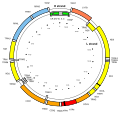Mitochondrial DNA: Difference between revisions
CSV import |
CSV import |
||
| Line 25: | Line 25: | ||
{{stub}} | {{stub}} | ||
== Mitochondrial_DNA == | |||
<gallery> | |||
File:Mitochondrial_DNA_lg.jpg|Mitochondrial DNA lg | |||
File:Mitochondrial_DNA_3D.webm|Mitochondrial DNA 3D | |||
File:Electron_microscopy_reveals_mitochondrial_DNA_in_discrete_foci.jpg|Electron microscopy reveals mitochondrial DNA in discrete foci | |||
File:Map_of_the_human_mitochondrial_genome.svg|Map of the human mitochondrial genome | |||
File:Human_karyotype_with_bands_and_sub-bands.png|Human karyotype with bands and sub-bands | |||
File:Mitochondrial_DNA_en.svg|Mitochondrial DNA en | |||
File:Mitochondrial_DNA_and_diseases.svg|Mitochondrial DNA and diseases | |||
File:Correlation_between_the_mtDNA_GC%_and_maximum_life_span_across_387_different_mammalian_species.png|Correlation between the mtDNA GC% and maximum life span across 387 different mammalian species | |||
</gallery> | |||
Latest revision as of 21:44, 23 February 2025
Mitochondrial DNA (or mtDNA) is the DNA located in mitochondria, cellular organelles within eukaryotic cells that convert chemical energy from food into a form that cells can use, adenosine triphosphate (ATP). Mitochondrial DNA is only a small portion of the DNA in a cell; most of the DNA can be found in the cell nucleus.
Structure and function[edit]
Mitochondrial DNA is circular and double-stranded. It contains 37 genes, all of which are essential for normal mitochondrial function. Thirteen of these genes provide instructions for making enzymes involved in oxidative phosphorylation. Oxidative phosphorylation is a process that uses oxygen and simple sugars to create adenosine triphosphate (ATP), the cell's main energy source. The remaining genes provide instructions for making molecules called transfer RNAs (tRNAs) and ribosomal RNAs (rRNAs), which are chemical cousins of DNA. These types of RNA help assemble protein building blocks (amino acids) into functioning proteins.
Inheritance[edit]
Mitochondrial DNA is inherited solely from the mother. Any mutations in this DNA can cause a range of diseases, known as mitochondrial diseases. These diseases can vary widely in symptoms and severity, as the distribution of the mutated DNA may vary between tissues.
Mitochondrial diseases[edit]
Mitochondrial diseases are a group of disorders caused by dysfunctional mitochondria. They are the result of either inherited or spontaneous mutations in mtDNA or nDNA which lead to altered functions of the proteins or RNA molecules that normally reside in mitochondria. Mitochondrial diseases take on unique characteristics both because of the way the diseases are often inherited and because mitochondria are so critical to cell function. The subclass of these diseases that have neuromuscular disease symptoms are often referred to as a mitochondrial myopathy.
See also[edit]
- Mitochondrial disease
- Mitochondrial myopathy
- Human mitochondrial genetics
- Mitochondrial biogenesis
- Mitochondrial inheritance
References[edit]
<references />
|
|
|
Mitochondrial_DNA[edit]
-
Mitochondrial DNA lg
-
Mitochondrial DNA 3D
-
Electron microscopy reveals mitochondrial DNA in discrete foci
-
Map of the human mitochondrial genome
-
Human karyotype with bands and sub-bands
-
Mitochondrial DNA en
-
Mitochondrial DNA and diseases
-
Correlation between the mtDNA GC% and maximum life span across 387 different mammalian species









